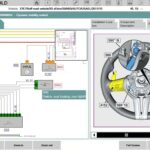Hexprog is a powerful tool designed for chip tuning, ECU cloning, and ECU repair. This comprehensive guide delves into the features and capabilities of Hexprog, highlighting its versatility and advanced functionalities. We’ll explore how Hexprog empowers technicians and enthusiasts to modify and repair engine control units with precision and efficiency.
Hexprog: A Deep Dive into its Capabilities
Hexprog offers a suite of features that cater to a wide range of automotive needs, from basic diagnostics to complex modifications. Let’s explore its key functionalities:
Chip Tuning and ECU Cloning with Hexprog
Hexprog excels in chip tuning and ECU cloning, enabling users to optimize engine performance and replicate ECU data. It supports an extensive list of ECUs/TCUs across various vehicle types, including cars, trucks, bikes, and tractors. Compatibility extends to both older and newer models from leading manufacturers like Bosch, Continental, Delphi, Marelli, Denso, Temic, TRW, and Valeo.
Hexprog allows reading and writing of essential memory types, including P-Flash, D-Flash, External Flash, and External EEPROM. The automatic checksum correction feature simplifies the process and ensures data integrity.
Flexible ECU Access Methods
Hexprog offers two distinct modes for accessing ECUs:
-
Bench Mode: This user-friendly mode eliminates the need to open the ECU cover. Simply connect the necessary power and signal wires to begin working with the ECU.
-
Boot Mode: For unresponsive ECUs, boot mode provides a solution. This requires opening the ECU and connecting a boot wire to the ECU board, enabling access and troubleshooting.
OBD Functionality for Diagnostics and Repair
Hexprog supports OBD functionality, allowing for crucial tasks such as:
- Virtual Reading: Access ECU data remotely.
- VIN Changing: Modify vehicle identification numbers.
- Coding Backup/Restoration: Save and restore ECU coding.
- Fault Code Reading/Erasing: Diagnose and clear error codes.
BMW ISN Reading
Hexprog boasts the capability to read the complete long ISN (Individual Serial Number) from any BMW ECU, including the latest Bosch MG1/MD1 ECUs found in DME/DDE models from 2005 to the present.
Hexprog vs. Hexprog II: A Comparative Analysis
While both Hexprog and Hexprog II offer powerful ECU programming capabilities, they cater to different needs. Hexprog II is a specialized tool focused on ECU repair and chip tuning, while Hexprog provides broader functionality, including support for Immo modules, CAS and BCM reading/writing, key reset, and EEPROM reset.
The following table highlights the key differences:
| Feature | Hexprog | Hexprog II |
|---|---|---|
| Microprocessor Speed | 220 MHz | 220 MHz |
| USB Speed | High Speed (480 Mbps) | High Speed (480 Mbps) |
| Powering ECU/TCU | Requires Power Module | Built-in |
| ECU Connection | Requires External Adapters | Built-in |
| OBD 24V | Not Supported | Supported |
| CAS Support | Supported | Not Supported |
| Key Reset | Supported | Not Supported |
| ECU List | Supports Most ECUs/TCUs | Supports All ECUs/TCUs |
| Warranty | 1 Year | 3 Years |
Conclusion: Choosing the Right Tool for Your Needs
Hexprog offers a versatile solution for a wide range of automotive programming tasks. Its comprehensive features, combined with user-friendly operation, make it a valuable tool for both professionals and enthusiasts. When choosing between Hexprog and Hexprog II, consider your specific requirements and prioritize the functionalities that best align with your needs. Whether you need the specialized power of Hexprog II for chip tuning and ECU repair, or the broader capabilities of Hexprog for Immo module and key-related tasks, understanding these differences is crucial for making an informed decision.

